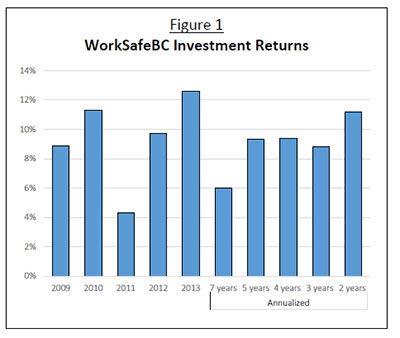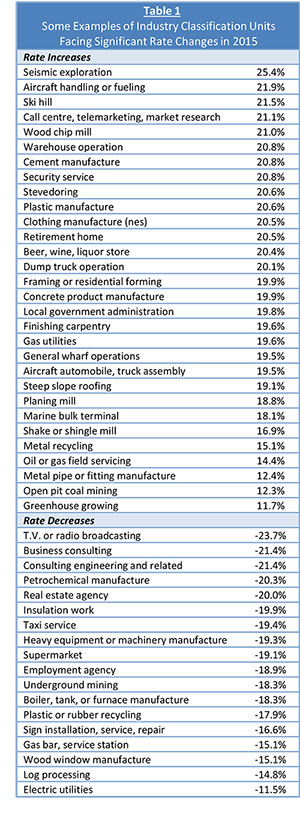WorkSafeBC Average Premiums Remain Stable in 2015
By Jock Finlayson
In a rare bit of good news for employers, WorkSafeBC has announced that the average “base rate” premium will remain unchanged in 2015. The average rate charged to employers has been set at $1.70 per $100 of assessed payroll, the same as in 2014.
After a few years of stable rates, the average WorkSafeBC base rate increased by around 5% in both 2013 and 2014. The prospect of a flat base rate will be welcomed by employers, who in recent years have faced a series of hikes in costs and prices controlled or influenced by the BC government – everything from fuel and corporate income taxes to water rental fees, Medical Services Plan premiums, and the cost of power.
The performance of WorkSafeBC’s investment portfolio has contributed to the agency’s improved financial position. Figure 1 summarizes its investment returns. For 2013 the portfolio posted a 12.6% total return. Over the past seven years, WorkSafeBC has outperformed the “median” WCB in Canada, although this was not the case in the four-, three- and two-year periods ending on December 31, 2013. Looking ahead, WorkSafe has prudently assumed modest investment returns. This reflects low bond yields and an expectation of sluggish economic growth for the major developed economies. In a low-return world, outsized investment results can’t be counted on to keep a lid on premiums. Hence, it will be important for employers to further reduce injury claims – and for WorkSafeBC to carefully manage the cost drivers in the system.

2015 Rate Changes by Industry
While the average base rate is stable for the coming year, the picture differs significantly across industry sectors. In 2015, 54% of employers will see lower rates while 44% will experience rate increases (there is no change for the remaining 2%). Almost 5% of employers will enjoy rate decreases of 20% or so next year. On the other hand, approximately 10% will face a jump of 20%.1 The variations in rate changes across industries is mainly due to different patterns of injuries and related claims costs. Employers in each rate group pay the costs of injuries and diseases that occur to workers within the group.
Table 1 lists some of the industry “classification units” expected to face significant rate increases in 2015, as well as several industry sub-groups in line for rate declines.2

Conclusion
WorkSafeBC’s total annual claims and operating costs exceed $2 billion. The agency’s revenues consist of premium income and investment income. All the premiums – totaling $1.24 billion in 2013 – come from employers. In dollar terms, annual premiums paid to WorkSafeBC are equivalent to about half of the corporate income tax collected by the provincial government.3 Employers therefore have a strong interest in WorkSafe’s financial health — as well as in ensuring that the system is properly managed and able to contain the upward pressure on costs. That is why the Business Council remains engaged with WorkSafeBC policy and regulatory issues. It is also why – together with other business associations – we are members of the Employers’ Forum, an organization that provides a platform for the business community to share information and work collaboratively to influence the operation of the WorkSafe system.4
Jock Finlayson is the executive vice president and chief policy officer with the Business Council of British Columbia.
1 Maximum one year rate changes are generally limited to no more than 20%.
2 There are 549 individual classification units that group together similar employers.
3 Budget 2014 projects that CIT collections will amount to about $2.3 billion in 2014-15.
4 The official name of the Employers’ Forum is the Employers’ Health and Safety Organization of British Columbia; see www.employersforum.org
This article was originally published by the Business Council of British Columbia, August 2014.







